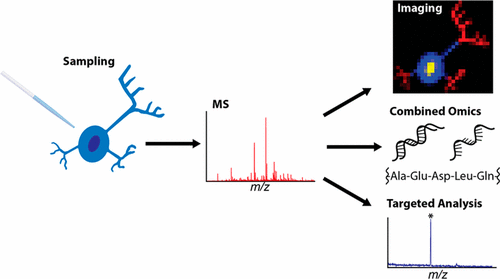当前位置:
X-MOL 学术
›
ACS Chem. Neurosci.
›
论文详情
Our official English website, www.x-mol.net, welcomes your
feedback! (Note: you will need to create a separate account there.)
Single Cell Neurometabolomics
ACS Chemical Neuroscience ( IF 4.1 ) Pub Date : 2017-10-19 00:00:00 , DOI: 10.1021/acschemneuro.7b00304 Meng Qi 1 , Marina C. Philip 1 , Ning Yang 1 , Jonathan V. Sweedler 1
ACS Chemical Neuroscience ( IF 4.1 ) Pub Date : 2017-10-19 00:00:00 , DOI: 10.1021/acschemneuro.7b00304 Meng Qi 1 , Marina C. Philip 1 , Ning Yang 1 , Jonathan V. Sweedler 1
Affiliation

|
Metabolomics, the characterization of metabolites and their changes within biological systems, has seen great technological and methodological progress over the past decade. Most metabolomic experiments involve the characterization of the small-molecule content of fluids or tissue homogenates. While these microliter and larger volume metabolomic measurements can characterize hundreds to thousands of compounds, the coverage of molecular content decreases as sample sizes are reduced to the nanoliter and even to the picoliter volume range. Recent progress has enabled the ability to characterize the major molecules found within specific individual cells. Especially within the brain, a myriad of cell types are colocalized, and oftentimes only a subset of these cells undergo changes in both healthy and pathological states. Here we highlight recent progress in mass spectrometry-based approaches used for single cell metabolomics, emphasizing their application to neuroscience research. Single cell studies can be directed to measuring differences between members of populations of similar cells (e.g., oligodendrocytes), as well as characterizing differences between cell types (e.g., neurons and astrocytes), and are especially useful for measuring changes occurring during different behavior states, exposure to diets and drugs, neuronal activity, and disease. When combined with other omics approaches such as transcriptomics, and with morphological and physiological measurements, single cell metabolomics aids fundamental neurochemical studies, has great potential in pharmaceutical development, and should improve the diagnosis and treatment of brain diseases.
中文翻译:

单细胞神经代谢组学
在过去的十年中,代谢组学,代谢物的表征及其在生物系统中的变化,已在技术和方法学上取得了长足的进步。大多数代谢组学实验都涉及对液体或组织匀浆中小分子成分的表征。尽管这些微升和较大体积的代谢组学测量可以表征数百至数千种化合物,但随着样品量减少到纳升甚至皮升的体积范围,分子含量的覆盖范围也会减小。最近的进展使得能够表征在特定的单个细胞内发现的主要分子。尤其是在大脑内部,无数种细胞类型是共定位的,通常这些细胞中只有一部分在健康和病理状态下都发生变化。在这里,我们重点介绍了用于单细胞代谢组学的基于质谱的方法的最新进展,强调了它们在神经科学研究中的应用。单细胞研究可用于测量相似细胞(例如少突胶质细胞)群体成员之间的差异,以及表征细胞类型(例如神经元和星形胶质细胞)之间的差异,并且对于测量在不同行为状态下发生的变化特别有用,饮食和药物暴露,神经元活动和疾病。当与转录组学等其他组学方法以及形态学和生理学测量相结合时,单细胞代谢组学将有助于基础神经化学研究,在药物开发中具有巨大潜力,并应改善脑疾病的诊断和治疗。
更新日期:2017-10-20
中文翻译:

单细胞神经代谢组学
在过去的十年中,代谢组学,代谢物的表征及其在生物系统中的变化,已在技术和方法学上取得了长足的进步。大多数代谢组学实验都涉及对液体或组织匀浆中小分子成分的表征。尽管这些微升和较大体积的代谢组学测量可以表征数百至数千种化合物,但随着样品量减少到纳升甚至皮升的体积范围,分子含量的覆盖范围也会减小。最近的进展使得能够表征在特定的单个细胞内发现的主要分子。尤其是在大脑内部,无数种细胞类型是共定位的,通常这些细胞中只有一部分在健康和病理状态下都发生变化。在这里,我们重点介绍了用于单细胞代谢组学的基于质谱的方法的最新进展,强调了它们在神经科学研究中的应用。单细胞研究可用于测量相似细胞(例如少突胶质细胞)群体成员之间的差异,以及表征细胞类型(例如神经元和星形胶质细胞)之间的差异,并且对于测量在不同行为状态下发生的变化特别有用,饮食和药物暴露,神经元活动和疾病。当与转录组学等其他组学方法以及形态学和生理学测量相结合时,单细胞代谢组学将有助于基础神经化学研究,在药物开发中具有巨大潜力,并应改善脑疾病的诊断和治疗。











































 京公网安备 11010802027423号
京公网安备 11010802027423号